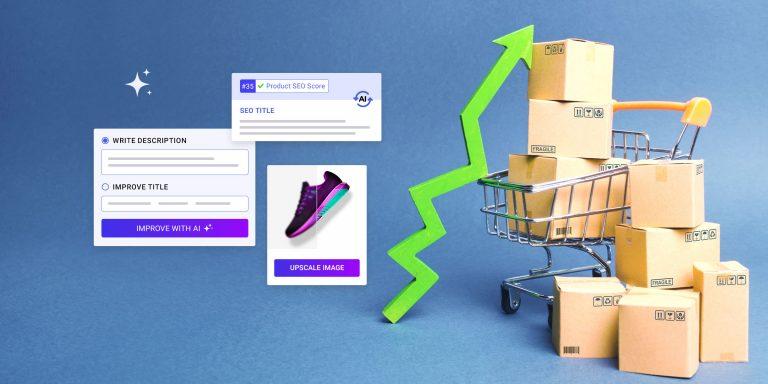In ecommerce and dropshipping the success of your business lies in the quality of the customer service. Otherwise, how will you deal with dissatisfied customers – who can tarnish your brand reputation and plummet sales?
One problem is that today consumers interact with businesses on an average of almost six touch-points, while nearly 50% regularly use more than four. This means heavier duty for the customer service team than ever.
How can we solve this and keep customers happy, while increasing sales on all channels? Keep reading and you will find 5 ecommerce omnichannel customer service best practices to follow.
Table of Contents
What is ecommerce omnichannel customer service?
Ecommerce omnichannel customer service integrates multiple communication channels to provide a consistent support experience for buyers across all touchpoints. These touchpoints include, but are not limited to, social media, phone, email, chat, or any other communication platforms that customers may consider their preferred channels to interact with the business.
With an ecommerce omnichannel customer service strategy, the business owner or support agent can access every digital and in-person interaction to set up a suitable counter-interaction. The seamless service across multiple channels is the cornerstone of an ecommerce omnichannel business’ success.
How can ecommerce omnichannel customer service help online retailers?
Customer service in ecommerce not only provides help regarding the products and services purchased but is also a strong factor that leads to building customer trust and confidence. In the new digital age with limited confrontations with customers, good eommerce customer service is an extremely powerful tool that helps brands stand out in increasingly crowded markets.
So, it is not simply about resolving some complaints; it is more about constantly conversing with consumers, understanding their needs, and even anticipating what they might need in the future.
Here are some benefits of an ecommerce omnichannel customer service dropshippers and retailers won’t want to miss:
– Customer convenience: The churn rate increases when you fail to meet the customer’s needs. Allow them to contact your support team through SMS, email, or online message on Instagram. With many easy options available, each conversation can start on a positive note.
– More satisfaction: Efficient and personalized support will help customers feel cared for. Based on research by McKinsey, customers feel more satisfied with longer digital service journeys.
– More loyalty: An omnichannel strategy is a must to increase customer retention over time. With more satisfaction, your brand can forge a stronger relationship and boost loyal brand advocates.
– Increased sales: Happy customers equals higher conversion rates and lifetime value scores. Focus on understanding the buyer, and you will get the sales.
– Improved brand reputation: In the long run, a brand reputation built on excellent customer service will help you differentiate from competitors. On the other hand, bad news has wings, and you don’t want your brand fame to plummet because of terrible handling with customer service.
– Better employee productivity: When the support team has the right tools and synced customer data, they can resolve customer issues more efficiently, resulting in better productivity and better focus.
– Transparency: With a transparent ecosystem, customer interactions are synced across channels for unified data. Customers can also receive the same messages everywhere, further enforcing the brand image.
Read more: Dropshipping vs Ecommerce: Understanding the Key Differences
5 best practices for ecommerce omnichannel customer service
Customer values will always be priceless for ecommerce and dropshipping businesses, no matter what changes in the future. The next 5 best practices will ensure the effective implementation of ecommerce omnichannel customer service and attract consumers no matter the situation.
1. Unify the customer service of all channels
Although your business interactions are spread among many channels, you can’t sacrifice the speed and quality of the customer service. Even as a small business, you need to implement an omnichannel support strategy to manage:
- Detailed data of past and current customer inquiries or conversations
- Existing and past orders with customer feedback (a powerful POS system can be helpful)
- Buyers’ personal information and other details
Organizations can find customer information from one source by unifying the data sources, avoiding wasting time searching for a single sales record. This tactic results in a streamlined work process with much faster and more accurate customer service.
At the heart of omnichannel customer service is automation. Customers’ questions or concerns can be addressed immediately if you can automate some or all parts of the support. For example, ticket tagging, automated emails, and post-purchase caring messages are just some tools you can use to nurture customers.
However, don’t forget the balance of the human touch in customer support. In areas where more personalization is better, consider automating partially like an auto-fill template for quick responses

2. Focus on the service convenience
All of us have run into some problems while buying online. The problem is made more complicated if it’s harder to pinpoint the issue during the buying journey. If you want to create a convenient purchasing experience, here are some parts to focus on:
– Promote your services on mobiles as an increased number of people are making their purchases through their cell phones. You should have a usable and effective mobile app and website for your ecommerce omnichannel business.
– Include a portal that would allow consumers to address their return issue. Consumers do not wish to wait for a long-anticipated mail if they are planning to return an item and instead expect immediate help.
– Provide options that allow the buyers to solve problems themselves during the buying process, for example, viewing the status of an order without contacting your store.
– Create an FAQ page where customers can try to find a solution to their problems. It is also recommended to update this information from time to time.
– Implement auto-fill forms for creating an account, completing the order, shipping an item, asking for a review, and many others.
3. Empower the support team
The customer support team is at the frontline in solving your customers’ issues every day. So make sure they are prepared to give buyers a good experience and represent your brand accurately. Here are some things you can do for your customer service team:
– Educate members of support team on all products and services you offer so they can guide the customers and help solve any problem.
– Ensure that the service team includes members from different channels and is composed of folks who received training on omnichannel support.
– Teach the service team to optimize the system and make part of their work easier, eliminating any time wasters that they may encounter. For instance, this system should enable in-store staff to be aware of how a payment POS system operates so that they can access details and support any particular buyer.
– Use new automated ways of customer support like using chatbots and artificial intelligence to support clients 24/7. In other words, there will always be a convenient time to help the buyers as you will be available anytime, anywhere.
4. Proactively connect with customers
Friendliness is vital to craft meaningful relationships with customers. In a store, you can greet consumers with a smile, but in the online world, how can you show the same attitude?
– Achieve better engagement rates with customers by using their names or service-specific details such as purchased items, reward points, or delivery information. This degree of service may persuade consumers via the Internet and develop an even more extended association.
– Sort customer concerns according to the frequency, characteristics, and effects. This is helpful in that it allows you to have an understanding of the buyers and make appropriate changes on an ongoing basis to solve the most frequent problems they might encounter.
– Scrape customers’ data across various touchpoints including social media, marketplace, websites, surveys, etc, and analyze to ensure that customers are pleased with products or services or to reassure them that a particular problem has been dealt with.
By proactively connecting with customers like this, your business demonstrates a commitment to provide a satisfying customer experience.
5. Set up and measure metrics for improvement
A major reason for adapting an omnichannel strategy is the data a business can gather. These are important metrics for analyzing the business process and customer behaviors.
Some metrics that eCommerce stores focus on are:
– Retention rate: This is the time visitors spend buying on your channels, which shows if customers are satisfied with your services and may come back.
– Net Promoter Score: This measures the satisfaction points and the chance a customer would recommend your business to others.
– Buying journey touchpoints: This shows the number of touchpoints a customer interacts with your business, which equals the channels you need to provide support.
– Sales number: This shows the effective sales power of all channels, so you can decide on an optimizing action such as removing a channel or allocating resources.
Final words
Nowadays, all businesses are investing heavily in omnichannel customer service, from banking, and travel, to healthcare and telecoms. So, ecommerce (or dropshipping) can’t stand out of the movement, especially when the omnichannel approach impacts revenue.
The best practices above are guidelines to reach an effective customer service experience through utilizing channels, focusing on customer experience, empowering employees, and improving by using data. Combine them well and your ecommerce channels will accelerate sales in a short time.












